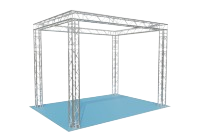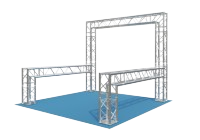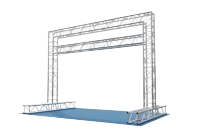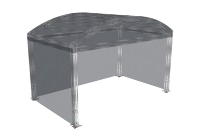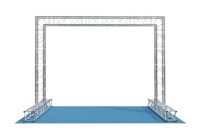Temporary Structures: Practical Frameworks for Events and Outdoor Projects
Short-term projects often face tight timelines, shifting briefs, and limited space. Temporary structures step in where permanent buildings are unsuitable, unavailable, or financially impractical. Built around modular components, these systems deliver reliable support for equipment, coverings, and signage in venues ranging from festival fields to urban construction plots.
Although temporary suggests a brief lifespan, modern frameworks are engineered for repeat deployment. Components are designed to be assembled, dismantled, transported, and stored with minimal fuss. The core element in many builds is the temporary truss, an interconnected lattice that balances strength with transportable weight.
Why a Temporary Truss Forms the Backbone of Many Builds
Across entertainment, retail, and industrial sectors, a truss structure provides three essential qualities:
- Load Capacity: The triangulated geometry distributes weight efficiently, allowing safe suspension of lights, speakers, banners, and coverings.
- Adaptable Geometry: Straight runs, corners, and angled sections combine to fit irregular footprints without invasive foundations.
- Rapid Assembly: Standardised joints and connectors let crews slot sections together quickly, reducing labour overheads and venue downtime.
Where crowd flow changes from one occasion to another, concerts one week, exhibitions the next, temporary event structures ensure fast turnaround without compromising safety.
Application Snapshots: From Market Stalls to Sporting Arenas
Because each project carries unique demands, temporary structures appear in diverse forms. Common examples include:
- Walkway arches at open-air festivals, guiding visitors between stages.
- Weather-proof bays for site offices on large infrastructure developments.
- Vendor canopies at seasonal markets, shielding stock and staff from rain or midday glare.
- Scoreboard supports at regional athletics meets.
- Pop-up retail pods inside shopping centres during peak trading periods.
Every scenario above benefits from equipment that can be scaled, shaped, and relocated without permanent groundworks.
Temporary Canopy Structure Options
Coverage against wind and rain is often as critical as load-bearing capacity. A temporary canopy structure fixes tensile membranes or fabric roofs to a dependable frame, delivering:
- Dry zones for catering or hospitality.
- Sunshade for merchandise displays.
- Sheltered queuing lanes improving customer comfort.
When paired with transparent or translucent fabrics, natural light can still penetrate while sensitive gear remains protected. The same framework can later carry solid cladding for winter installations, highlighting the versatility of modular designs.
Temporary Event Structures Considerations
Before the first pallet leaves the warehouse, a clear brief prevents costly on-site alterations. Key checkpoints include:
- Site Survey: Confirm gradients, underground services, and surface composition. Hard standing may allow ballast, while grass or gravel might require ground screws or stake anchors.
- Local Regulation: Temporary outdoor structures sometimes fall outside standard building approvals; nonetheless, local authorities still monitor public safety. Understanding regional guidelines on duration and height streamlines sign-off.
- Load Calculations: Audio arrays, LED panels, or canvas skins each exert different forces. Factoring dynamic loads, wind, movement, or vibrations, prevents structural fatigue.
- Access and Egress: Layouts must enable smooth evacuation routes, plant machinery movement, and service vehicle access.
Once these variables are confirmed, the engineering team can specify component grades, base plates, and bracing without guesswork.
Temporary Outdoor Structures Beyond Entertainment
While festivals often steal the headlines, many other sectors rely on modular systems:
- Healthcare: Drive-through testing booths and vaccination hubs.
- Agriculture: Seasonal produce grading lines assembled within days, then collapsed post-harvest.
- Education: Overflow teaching spaces during renovation projects.
- Public Works: Pedestrian bridges spanning excavation trenches or waterways.
The ability to redeploy the same temporary structure elsewhere keeps capital expenditure low and environmental impact modest.
Truss Structure Design Trends: Lightweight Components, Heavier Expectations
Modern projects often demand greater spans or taller clearances without additional crew hours. Manufacturers respond with refined alloy profiles, higher tensile fastening systems, and intuitive labelled parts. This evolution supports:
- Clear bays free of obstructive internal columns.
- Creative lighting rigs that shift focus points mid-event.
- Temporary media screens matching commercial billboard sizes.
With expectations rising, documentation remains vital. Detailed drawings, load tables, and inspection records assure insurers, councils, and event owners that each temporary truss complies with recognised standards.
Key Terms at a Glance
- Temporary Structures: Broad category covering any short-term framework or enclosure.
- Temporary Truss: Modular lattice beams joined by specialised connectors, supporting loads in temporary applications.
- Truss Structures: A wider term including towers, goalposts, bridges, and grids built from truss components.
- Temporary Event Structures: Complete installations for concerts, exhibitions, or corporate functions.
- Temporary Canopy Structure: A fabric or panel roof mounted on a supporting frame, often truss-based.
- Temporary Outdoor Structures: Any short-term build exposed to external weather conditions.
Summary
Temporary structures stand at the intersection of efficiency, safety, and adaptability. Whether required for a weekend fair or a six-month infrastructure build, the temporary truss remains a cornerstone component. By pairing modular engineering with thorough planning, project teams secure reliable coverage, load support, and visual impact without permanent alteration to the site.


